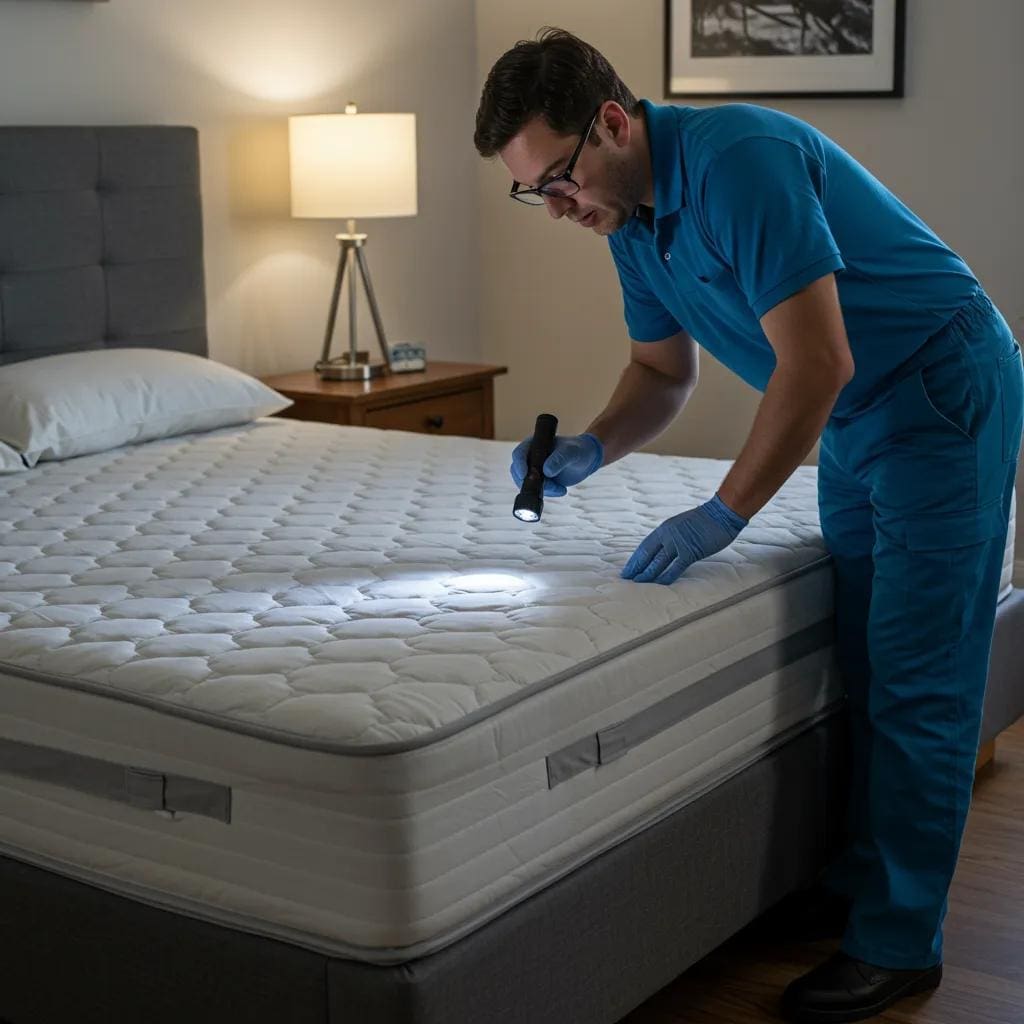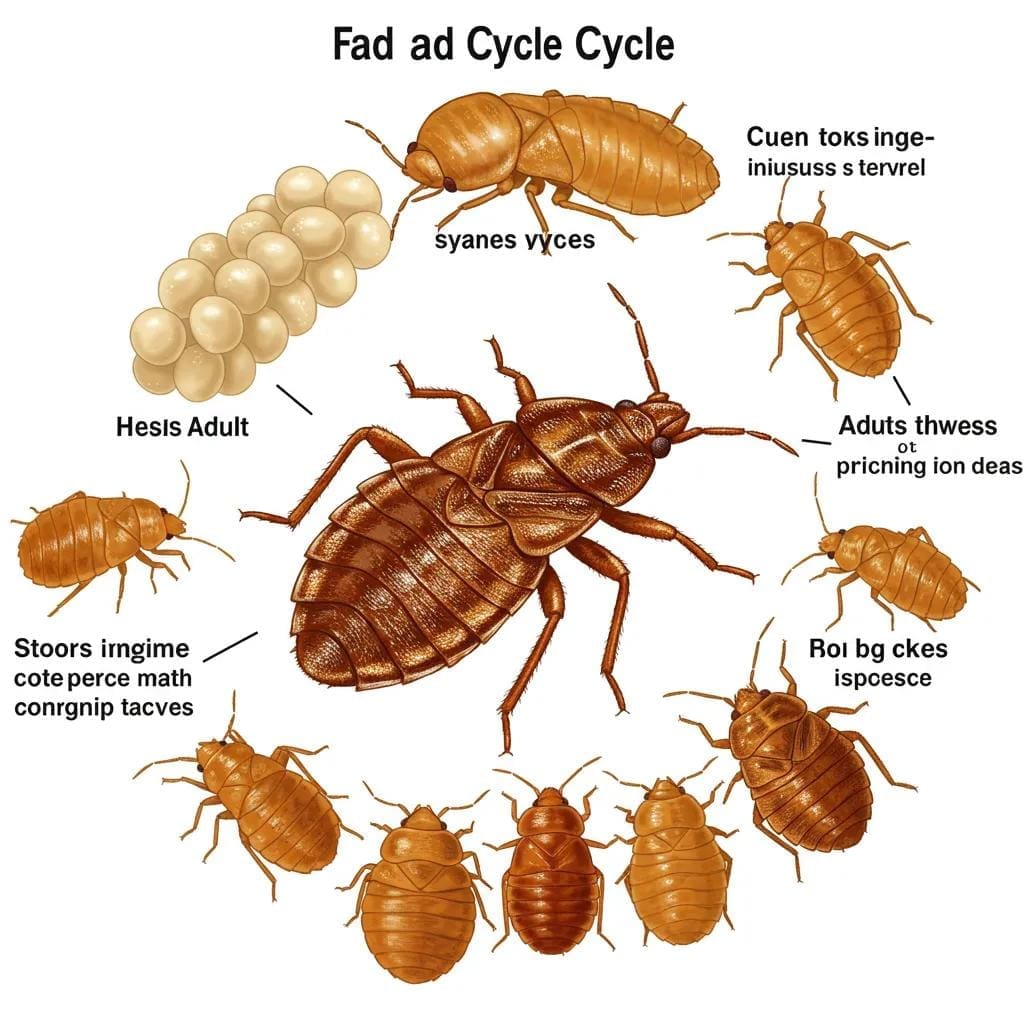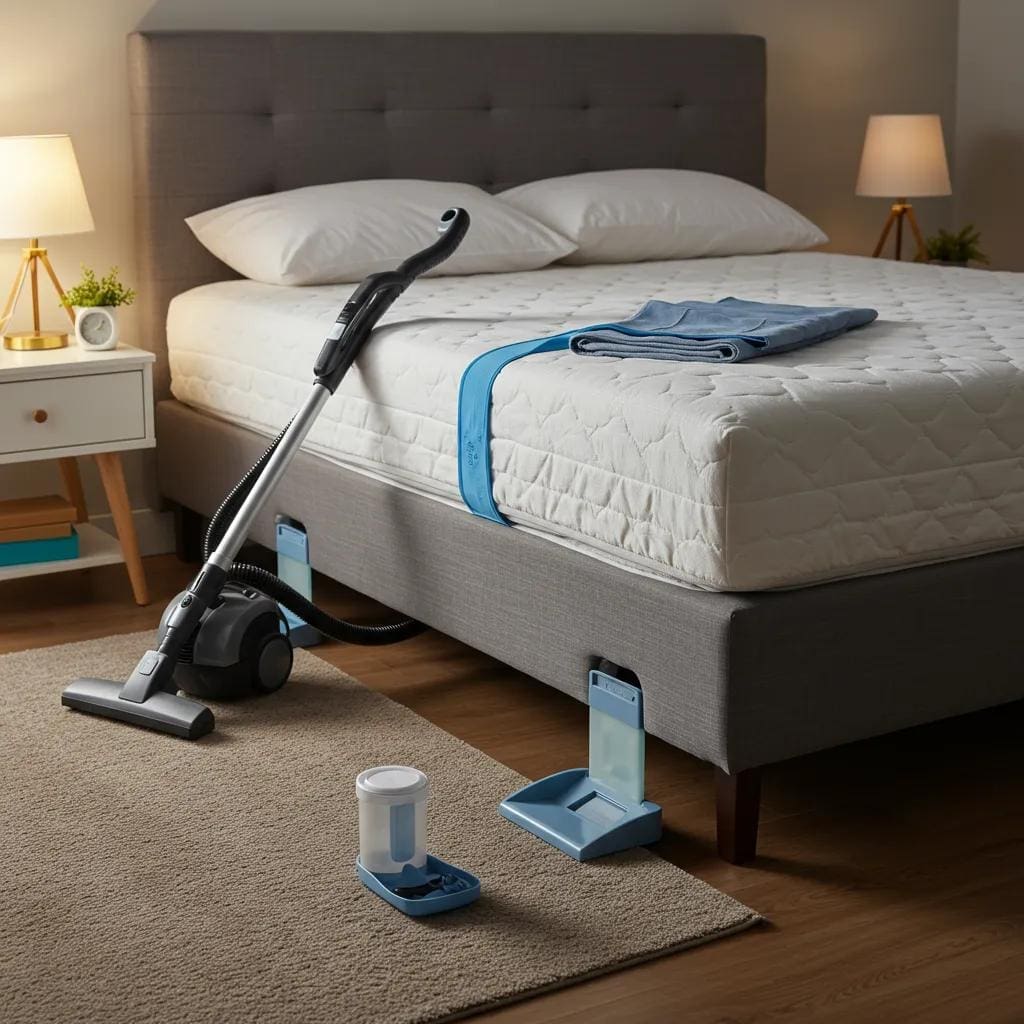
Expert Bed Bug Extermination: Guaranteed Solutions for Your Peace of Mind
Tackling bed bugs requires a sharp eye, skilled hands, and proven methods. Pest Dominion’s certified experts deliver guaranteed eradication with minimal fuss. With bed bug reports surging by over 65% across the UK between 2022 and 2023, swift action and precise treatment plans are crucial for safeguarding your home and business. This guide will equip you with the knowledge to identify these pests (Cimex lectularius), explore advanced heat and chemical eradication techniques, master prevention strategies for home and travel, understand how to select a top-tier exterminator, get a handle on service costs, compare natural remedies with professional control, and clear up common concerns. By integrating Pest Dominion’s trusted four-step process and British Pest Control Association (BPCA) accreditation throughout, this article ensures you’re fully informed on all aspects of bed bug control and prevention.
Understanding Bed Bugs: Identification, Habits, and Infestation Clues
Bed bugs are tiny, flightless insects that feed on blood and can cause itchy bites, allergic reactions, and significant stress. Knowing their habits and biology is key to early detection and effective treatment, preventing widespread infestations. Understanding Cimex lectularius’s preferred hiding spots and life cycle is the first step towards targeted eradication, robust prevention, and seamless integration with Pest Dominion’s assessment procedures. This section covers the defining traits of bed bugs, clear signs of their presence, and their developmental stages.
What Defines Cimex lectularius? Key Bed Bug Characteristics
Cimex lectularius is the common bed bug species notorious for infesting sleeping areas and staying close to their human hosts. Adult bugs are about 4–5 mm long, with a flat, oval shape that turns reddish after a blood meal. They typically hide in mattress seams, furniture joints, and wall cracks during the day, emerging at night to feed unnoticed. Their slim bodies allow them to squeeze into tight spaces, making them hard to spot without a thorough inspection. Knowing these characteristics is vital before looking for infestation signs.
How Can You Spot Signs of a Bed Bug Infestation?
Before any treatment begins, it’s essential to confirm their presence by looking for specific indicators. Here are the most common signs that call for immediate professional attention:
- Small blood stains on your bedding or pillowcases, often from crushed bugs.
- Tiny dark spots or smears on mattress seams and edges – these are digested blood droppings.
- Shed skins, known as exuviae, which are pale and brittle, are found in corners or under furniture.
- Clusters of minuscule eggs, about 1 mm in size, are often hidden in crevices.
- Itchy red bites frequently appear in lines or clusters on exposed skin.
These physical and skin-related clues, when seen together, provide a strong basis for a targeted inspection. Confirming an infestation through these signs naturally leads to understanding the bed bug life cycle and choosing the right treatment methods.
What Does the Bed Bug Life Cycle Entail?

Understanding the bed bug life cycle is crucial for timing treatments and follow-up checks effectively.
The following table details each stage:
| Stage | Approximate Duration | Key Features |
|---|---|---|
| Egg | 6–10 days | Tiny, white, oval, hidden in cracks and crevices |
| Nymph (5 Instars) | 5–8 days per stage | Moults five times, requires blood meals between stages |
| Adult | Up to several months | Mature, capable of reproduction after feeding |
| Reproduction | Ongoing | Females can lay up to five eggs per day under ideal conditions |
Hatching and nymph development depend on regular blood meals. Disrupting this feeding cycle through professional intervention significantly slows population growth. Knowing these stages helps in selecting the most appropriate treatment strategies, whether heat, chemical, or integrated methods, as discussed next.
Top Bed Bug Treatment Methods in the UK: Effective and Safe Solutions
Effective bed bug eradication in the UK combines meticulous inspection with advanced, safe treatment technologies. Given the increasing resistance to older insecticides, Pest Dominion prioritises eco-friendly heat treatments, complemented by targeted chemical applications and Integrated Pest Management (IPM) principles. These methods ensure rapid results, long-term control, and full compliance with BPCA standards.
How Does Heat Treatment Eliminate Bed Bugs?
Heat treatment eradicates all bed bug life stages by raising room temperatures to lethal levels without using chemicals. Our technicians use industrial heaters and precise climate monitors to maintain temperatures between 50–60 °C for several hours, ensuring eggs, nymphs, and adults are eliminated. This chemical-free method bypasses resistance issues and provides immediate results, often in a single visit.
It’s worth noting that while heat treatment is highly effective, ensuring lethal temperatures reach all hiding spots can be a complex challenge.
Bed Bug Control: Challenges and the Effectiveness of Thermal Remediation
Controlling bed bugs can be challenging and typically necessitates both chemical and non-chemical treatments. A prevalent non-chemical method for bed bug management is thermal remediation. However, in certain circumstances, bed bugs have been observed to survive heat treatments. Bed bugs may persist following a heat treatment due to (i) abiotic factors related to the inability to achieve lethal temperatures within harborage areas for an adequate duration, (ii) re-infestation from insects that migrated to cooler zones during a heat treatment, or (iii) the development of physiological resistance enabling survival of heat exposure.
Bed bugs (Cimex lectularius L.) exhibit limited ability to develop heat resistance, AR Ashbrook, 2019
| Treatment Type | Temperature Range | Primary Advantage |
|---|---|---|
| Whole-Room Heat Treatment | 50–60 °C | Eliminates all life stages, including eggs, in one application |
| Targeted Heat Application | 70–90 °C (spot treatment) | Effectively treats specific, hard-to-reach harbourage zones |
The effectiveness and speed of heat treatment make it a core component of Pest Dominion’s service offerings, seamlessly leading into our chemical and holistic strategies.
What Advanced Chemical Treatments Are Used for Bed Bugs?
Our chemical treatments utilise three primary insecticide classes to combat resistance and provide lasting residual protection:
| Active Ingredient Type | Method of Application | Potential Resistance Issues |
|---|---|---|
| Pyrethroids | Surface sprays | Increasing resistance observed in some bed bug populations |
| Neonicotinoids | Residual barrier treatments | Lower cross-resistance compared to older insecticide classes |
| Insect Growth Regulators (IGRs) | Applied as disruptors | Interfere with moulting and egg development processes |
Professional application by our certified Pest Dominion technicians ensures correct dosages, precise coverage, and strict adherence to health and safety guidelines. Combining these treatments with advanced monitoring devices maximises elimination success while minimising environmental impact.
What Is the Integrated Pest Management (IPM) Strategy for Bed Bugs?
Integrated Pest Management (IPM) is a comprehensive strategy that blends inspection, prevention, non-chemical methods, and targeted chemical controls for a holistic approach. The key steps in our IPM process include:
- Thorough site assessment to pinpoint all infested areas.
- Physical removal of harbourages and meticulous vacuuming.
- Strategic application of heat or approved insecticides to key locations.
- Installation of protective mattress encasements and interceptor traps.
- Ongoing monitoring and follow-up visits to confirm complete eradication.
This layered methodology reduces reliance on any single control method, helps prevent resistance development, and minimises the use of chemicals. IPM’s adaptable nature makes it suitable for various UK housing types, ensuring durable, long-term control.
Preventing Bed Bug Infestations: Essential Home and Travel Strategies
Prevention is the most effective and cost-efficient defence against bed bugs. By adopting smart home hygiene practices and cautious travel habits, you can significantly lower the risk of introduction and maintain peace of mind.
What Are the Best Bed Bug Prevention Tips for Your Home?

Staying vigilant at home is your primary defence. Key preventative measures include:
- Use high-quality mattress and box spring encasements designed to trap and starve any existing bed bugs.
- Minimise clutter to remove potential hiding spots and make inspections easier.
- Regularly vacuum your bedrooms, wardrobes, and sofas, paying close attention to seams and corners.
- Launder bedding and clothing weekly at 60 °C to ensure any eggs are destroyed.
- Install monitor traps beneath bed legs to detect early signs of an infestation.
Implementing these habits creates an environment less hospitable to bed bugs and alerts you to any emerging issues. Consistent application of these steps complements effective travel prevention strategies.
How Can You Avoid Bringing Bed Bugs Back from Travel?
Your travel habits can significantly impact your risk of encountering bed bugs in hotels or on public transport. Follow these precautions:
- Visually inspect mattress seams, headboards, and furniture joints upon arrival at your accommodation.
- Keep your luggage elevated on racks or in the bathroom, away from the bed.
- Store clothing in sealed plastic bags or specialised suitcase liners.
- Upon returning home, immediately wash all travel garments at a high temperature.
- Avoid bringing used furniture or luggage directly into your home without professional inspection and treatment.
These travel-smart tips minimise the chance of hitchhiking bed bugs and protect your home environment wherever you go. With prevention covered, the next logical step is selecting the right professional service.
Choosing a Professional Bed Bug Exterminator: What to Look For
Selecting a qualified professional ensures safe, effective, and compliant pest eradication. Key factors to consider include accreditation, proven methodologies, local knowledge, and positive client reviews.
Why Partner with Pest Dominion for Bed Bug Control?
Pest Dominion distinguishes itself through BPCA accreditation, Trustmark registration, and a comprehensive elimination guarantee. Our technicians are extensively trained in advanced heat and chemical protocols, ensuring minimal disruption and maximum safety for your household. We also offer environmentally conscious options and transparent pricing, building trust and providing relevant solutions. These credentials highlight our expertise and dedication to delivering reliable pest control tailored to local conditions.
What Is Pest Dominion’s Proven Bed Bug Control Process?
Our structured four-step treatment process ensures thorough coverage and effective results:
- Inspection – A detailed examination to accurately map the extent of the infestation.
- Preparation – Clear guidance for homeowners on the necessary steps to expose hidden hotspots.
- Treatment – Strategic deployment of heat, chemical, or combined methods as appropriate.
- Verification – A follow-up visit with monitoring devices to confirm complete eradication.
This clear, sequential approach demonstrates Pest Dominion’s strategic and efficient methodology. Understanding this process naturally leads to hearing from satisfied clients who have experienced its benefits.
What Do Local Customers Say About Our Bed Bug Services?
Our local testimonials frequently praise our rapid response times, professional and courteous technicians, and the complete peace of mind we provide. Clients commend our thorough inspection reports, effective elimination often achieved on the first visit, and reassuring follow-up checks. These endorsements reflect our commitment to customer satisfaction and relevance. Such feedback effectively concludes our discussion on professional selection and transitions smoothly into service cost considerations.
Understanding the Costs of Bed Bug Extermination Services
Service pricing is influenced by the severity of the infestation, the size of your property, and the chosen treatment method. We provide transparent estimates and flexible options to suit every budget, ensuring you only pay for the services you need.
What Is the Typical Cost of Professional Bed Bug Treatment?
The following table provides an estimate of typical cost ranges based on property size and service level:
| Property Size | Estimated Investment | Factors Affecting Cost |
|---|---|---|
| Studio/One-Bedroom Flat | £250–£400 | Number of rooms and accessibility |
| Two- to Three-Bedroom Home | £450–£700 | Severity and spread of infestation |
| Larger Properties | £700–£1,200+ | Number of treatments required |
A final, precise quote is always provided after a complimentary inspection to assess the scope of work. Clear cost breakdowns empower you to make informed decisions, leading us to explore more budget-friendly options below.
Are There Affordable Options for Bed Bug Removal?
Pest Dominion offers tiered service packages, including basic inspection-only visits and comprehensive heat treatments. We also provide payment plans and discounts for multiple properties, making professional pest control more accessible. Combining preventative encasements with targeted spot treatments can reduce the overall cost while maintaining high efficacy. These options balance affordability with effective performance for every household.
Natural Bed Bug Remedies: Do They Work? DIY vs. Professional Treatment
While DIY remedies might seem appealing for budget-conscious individuals, understanding their limitations is crucial for effective and safe pest management. Comparing common natural solutions with professional interventions clarifies when expert assistance is truly necessary.
What Are Common Natural Bed Bug Remedies and How Effective Are They?
Home remedies vary in their effectiveness:
- Diatomaceous Earth: This abrasive powder dehydrates exposed insects but struggles to reach hidden populations.
- Essential Oils: Sprays made from oils like clove or tea tree may offer temporary repellency but lack lasting impact.
- Steam Treatments: Portable steamers can kill bugs on contact but require meticulous application to cover all areas.
- Vacuuming: Effective for removing visible insects, but it misses eggs and those deep within cracks.
While these methods can offer some relief, their reach is often limited. Recognising these constraints helps explain why professional, comprehensive approaches are typically required for complete eradication.
When Is Professional Bed Bug Control Essential?
Professional intervention becomes necessary when infestations:
- Involve more than just a few visible insects per room.
- Persist despite multiple DIY treatment attempts.
- Occur in shared living spaces or commercial environments.
Expert teams provide comprehensive IPM, advanced heat treatments that penetrate hidden areas, and ensure compliance with UK pesticide regulations. Engaging professionals at these stages prevents costly re-infestations and ensures a swift, long-term solution.
Frequently Asked Questions About Bed Bugs
Common concerns about bed bugs often centre on identification, elimination methods, and prevention strategies. Understanding these frequently asked questions can build confidence and guide your next steps.
How Can I Be Sure I Have Bed Bugs?
Early detection relies on spotting key signs: blood spots on bedding, dark droppings on furniture, shed skins, and itchy red bites often in lines or clusters. A thorough inspection using a bright light, focusing on mattress seams, headboards, and electrical outlets, can confirm their presence. Our professional technicians use specialised tools and monitoring devices to ensure no sign is missed.
What Kills Bed Bugs Instantly?
High temperatures, achieved through steam or whole-room heat treatments, can kill all bed bug life stages almost instantly. Certain fast-acting contact insecticides also provide immediate knockdown, though follow-up treatments are usually needed for eggs and hidden bugs. Combining heat with targeted residual treatments offers both immediate and lasting control.
Is Complete Bed Bug Elimination Possible?
Yes, complete eradication is achievable through a combination of precise inspection, appropriate heat or chemical application, and diligent follow-up monitoring. A guarantee of elimination, like the one offered by Pest Dominion, reflects our confidence in this structured approach and addresses potential resistance issues. Success depends on professional execution rather than sporadic DIY efforts.
What Causes Bed Bug Infestations?
Bed bugs typically spread through human travel, the acquisition of second-hand furniture, or from neighbouring infested units in apartment buildings. A single pregnant female can establish a new colony after travelling on luggage or within upholstered items. Awareness of these common sources is key to effective prevention, reinforcing the need for professional mattress encasements and careful travel hygiene.
How Can Bed Bugs Be Eliminated Permanently?
Permanent elimination requires a systematic approach involving:
- Meticulous inspection to identify all infestation areas.
- Application of heat and approved insecticides targeting every life stage.
- Installation of physical barriers like protective encasements.
- Scheduled follow-up visits to confirm their complete absence.
Combining behavioural changes, such as regular laundering and decluttering, with Pest Dominion’s accredited professional service ensures lasting peace of mind.
The precise temperature and time parameters for effective whole-room heat treatments are still being researched due to the complexities of heat penetration and bed bug behaviour.
Efficacy of Bed Bug Heat Treatments: Temperature and Time Parameters
However, the temperature and time parameters required for efficacy in whole-room heat treatments remain unknown, owing to the slower rate of heat penetration into harborage areas and the potential for bed bugs to seek out cooler microclimates within a room.
Temperature and Time Requirements for Controlling Bed Bugs (Cimex lectularius) under Commercial Heat Treatment Conditions, SA Kells, 2011
Pest Dominion provides a comprehensive solution—from accurate identification and understanding bed bug biology to employing advanced heat and chemical treatments, implementing best prevention practices, offering transparent pricing, and comparing natural remedies—giving a clear path to a bed bug-free environment. By leveraging accredited processes, cutting-edge monitoring technology, and unwavering customer support, we ensure every home and business achieves lasting protection. For personalised advice and a complimentary inspection, trust Pest Dominion’s proven expertise to restore your comfort and safety.

